The premise is simple: read one comic every day for the entire year. It seems like a simple task but there is no way that I read 365 comics last year, even if you count the individual issues in collections. So, this year, I am committing myself to this reading challenge, in the hope that I can broaden my reading habits and fully engage with my favorite hobby again.
What is your comic book holy grail? That one comic that, if money wasn’t an issue, you would buy and cherish more than your favorite child?* For me it would be Saru no Wakusei, the Japanese adaptation of Planet of the Apes written by Joji Enami and first published in 1968. The reason for this choice is that Apes is my favorite franchise when taking comics, books and related tie-ins into account, and this is the first comic of the franchise — published long before Marvel got in on the act.
As to why Planet of the Apes is my favorite franchise, I think Corinna Bechko sums it up best in her introduction to The Sacred Scrolls: Comics on the Planet of the Apes:
“In the same way that a prism appears to be a simple lump of glass until it is held up to produce visible rainbows from invisible clear light, the seemingly simplistic setup of a world where apes evolved from men allows us to view every facet of society from a different angle with a fresh perspective.”
So, with that in mind I’m going to read a bunch of different Ape comics, from various eras of publishing to see how they differ and what elements stay the same.
*If my kids are reading this, I love you both equally!
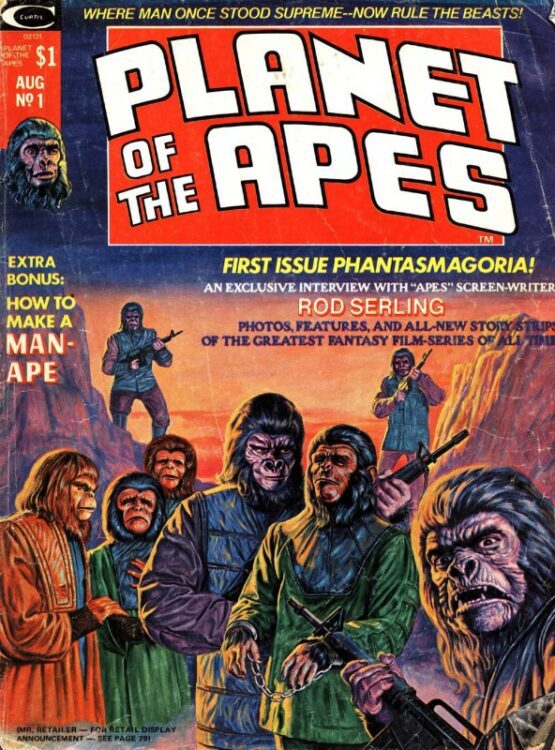
Credit: Marvel Comics
Comic Number 168: Planet of the Apes #1 (Marvel Comics 1974)
Over the years I have collected a number of Planet of the Apes comics. Most of the early Marvel ones that I own are from the UK weekly that included backup stories from other comics. However, thanks to the wonderful Hunter’s Planet of the Apes Archive website, you can access copies of the original comics as published, along with other, less known treats.
The original Marvel Apes products were published in a magazine format with a mix of text articles and comic strips. Issue 1 included the first part of Terror on the Planet of the Apes written by Doug Moench and illustrated by Mike Ploog. This is the start of one of the most famous comic book runs of the franchise, and from the very beginning you can see why it is much loved. The story is fast paced, thrilling, and populated with strong characters while the art is superb on every front.
After the first few chapters of Terror, the magazine has a few articles about the film series and an interview with original scripter Rod Serling, before concluding with the first part of Marvel’s adaptation of the first movie. Again the artwork is wonderful but it lacks the depth and finesse of Ploog’s work on the opening comic strip. The opening sequence with the crash of the Icarus onto the planet is dynamic and powerful and demonstrates the commitment the creators had to producing a good comic — not just an easy adaptation. Several pages of silent panels are dedicated to the scene-building suspense and setting the uncomfortable atmosphere that follows for most of the strip. Doug Moench, George Tuska, and Mike Esposito capture the spirit and pacing of the movie (if not the likenesses of the actors) in superb fashion, giving the readers a perfect stand-in for the actual movie, which had long since disappeared from the cinema.
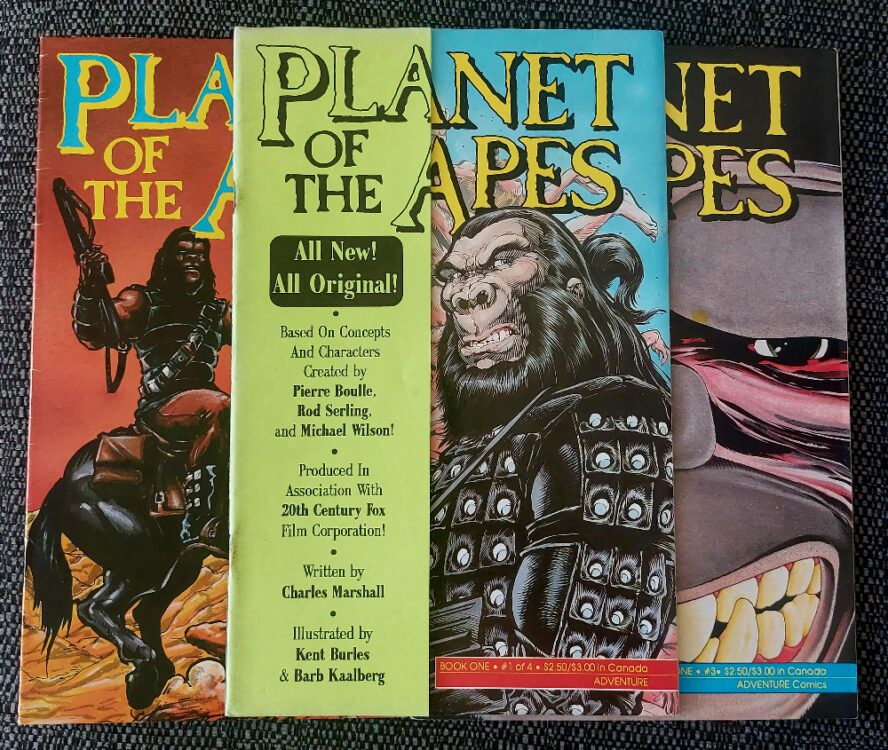
Credit: Malibu Comics
Comic Number 169: Planet of the Apes (Adventure Comics 1990) #1
After the end of the Marvel run, there was a long dry patch for Apes comics. From 1977 to 1990 there were no new Apes comics on the market unless you could read Hungarian*. Then, Malibu Graphics Inc bought up the license and Charles Marshall took the reins. Over the period of three years, Malibu would publish 50 plus Apes comics under their Adventure Comics imprint, with the main title, Planet of the Apes (obviously) taking up 24 of those issues.
On the opening arc, Charles Marshall worked with penciller Kent Burles and inker Barb Kaalberg to reinvent the look and tone of the Apes franchise. The visual element of the strip is the part that stands out most during this run, with the apes looking markedly different to their depiction in the movies and Marvel comics of the 1970s. I don’t think I would be out of place to suggest that the design of these apes was influenced by the late 1980s action movies and the overtly macho visual that was becoming a big part of the comic industry. The first few pages of this first issue contains a number of different ape characters and each one is heavily built with bulging muscles and an overpowering physical presence. Even the human characters, when they do turn up, are fairly buff, but the difference in size and stature is emphasized in every panel. Charles Marshall’s apes are true beasts.
Set shortly after the fifth movie, the Adventure Comics series has more aggressive apes with violence as a major component to the narrative. Some of the humans have speech and high intelligence, but others do not. A lot of the details of the world are not examined or explained but the physical planet itself, with various locations and features, is explored at great length, especially in some of the mini-series from this era (see below). As the story moves into the Forbidden Zone, grotesque mutants are introduced and new species of ape.
This iteration of Planet of the Apes is jarring compared to the other entries into the franchise, especially because of the visual direction that the creators took. It looks, feels, and reads like a small independent publication, with more stylistic artwork and a fast paced plot. There is the sense that everything has to be included at once because no-one is sure if they’ll get another issue. I personally am not a fan of the artwork, and I do find the scripting to be awkward at times. Some of the speech is real B-Movie standard, which is kind of fitting for the franchise, but it doesn’t read like a knowing nod to the heritage of the movies. Exposition is dropped into the speech and the captions to advance the story as quickly as possible.
Having said that, this series is a thrilling ride, if you can accept the artwork and speed through it at the same rate as the writer. Read it, don’t question it, enjoy it, and move on. Wasn’t that the mantra for 1990s comic industry?
*The original novel was adapted into a comic, A Majmok bolygója, and published in Hungarian in 1981. According to Wikipedia it has never been officially translated, however there are fan translations available online.
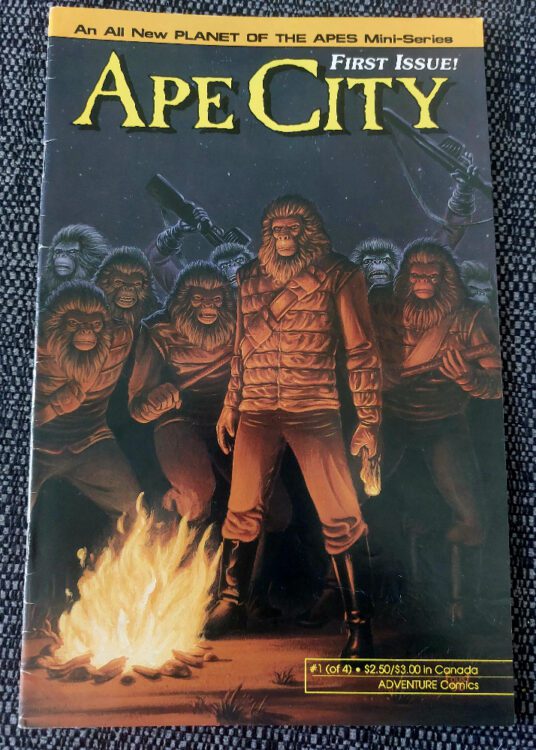
Credit: Malibu Comics
Comic Number 170: Ape City #1
Adventure comics published 24 issues under the title Planet of the Apes. They also published a small collection of miniseries and annuals set on, or around, the same world. Ape City was their first spin-off and it was something a bit different, as Charles Marshall notes in the introduction: “Instead of more mean gorillas and apes shooting it up on horseback, I [Marshall] had a vision of a pack of gorillas on big, mean Harleys, tearing down a deserted highway like the Horsemen of the Apocalypse”.
The artists are different from the main title, with M.C. Wyman on pencils and Marvin Perry Mann on inks, which means that the look of the comic is also different. The apes are more in line with the movie visual, although they still suffer from broad shoulders and exaggerated physiques.
Set in Europe at roughly the same period as their other title, Ape City throws everything at the wall and doesn’t bother to stop and check if any of it sticks. There are ape lounge singers, ape gangsters, ape scientists, ape ninjas, and a time-traveling human suicide squad hell bent on killing 500,000 apes for reasons that don’t really matter. This comic is like a bag of frogs. Heavily armed frogs. Heavily armed, cliché-spouting frogs. With a guitar.
Out of all of the Apes comics I have read, this is the one that I feel people will either love or hate with no room for mixed feelings. It has some great qualities, the artwork is much better than the sister title, but it suffers from a plot that makes little sense and a pace that is nearly fast enough to send the daughter of George Taylor into the future to find her father. Oh yeah, that’s one of the narrative threads in this story.
They took a risk with Ape City and it succeeded to a point. It demonstrated that it was possible to tell stories in this franchise that were new and different from the original without drifting too far from the core element of the world. The more advanced city aspect of the narrative makes sense in this comic. An army of 1940s style gangster apes, less so.
But it’s all fun until the humans show up. The depiction of the humans in this miniseries is the one element that dates this comic. They are archetypes of the early 1990s comic book heroes, or anti-heroes depending on your viewpoint. Early Image Comics are full of these types of macho, weapon wielding, thugs. It’s not clear if you are supposed to be on their side or not. I think that Marshall was probably hoping the reader would support them in the same way that an audience is on the side of the Suicide Squad, but there is nothing to like about these characters. They take the fun out of an otherwise enjoyable romp.
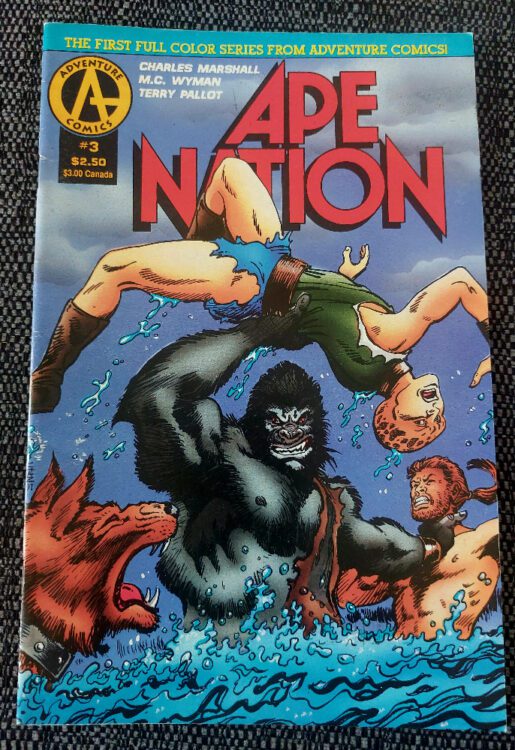
Credit: Malibu Comics
Comic Number 171: Ape Nation #3
Ape Nation was another miniseries published by Adventure Comics. It was a four-issue crossover with another of their licensed properties, Alien Nation. I have included issue 3 because I only have this issue, however, the comic is quite fascinating. It is the first example of a cross-over with the franchise, something that BOOM! Studios would pick up and run with in the 2010s, and the first full-color series from the publisher.
From a narrative point of view, the inclusion of the Tectonese into the Planet of the Apes story makes perfect sense here. Marshall creates a credible plot and one that doesn’t really alter the timeline of the original movies (there is a sense of alternative dimensions from the narrative but without the other issues I never really followed it. To be honest, it actually doesn’t matter). Alien Nation was chosen as a partner for the apes partly due to ease (the publisher owned the rights to both), but also because the B-Movie nature of both franchises made them comfortable bedfellows. The outlandish stories both have the same contextual undergrowth: the examination of difference and racism. Unfortunately, that isn’t something that is really developed in this series but it lays the groundwork for future endeavors.
A quick word on the artwork: it is fantastic. M.C. Wyman and Terry Pallot use very fine lines and clearly love drawing individual strands of hair. The colorist is David de Vries and they are the one who makes this version of Planet of the Apes different and more exciting that the other Adventure Comics runs. There are clear contrasts between the species which are then made more subtle when dealing with particular characters. Each page immediately sets the scene, outside or inside, and the contrast between landscape and characters is immediately noticeable so that the reader can identify character and location before reading any of the text. The colors in this comic make it easier to follow the narrative and is a great addition to this era of ape stories.
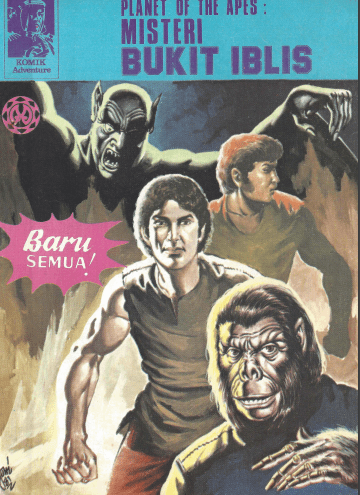
Credit: Maranatha
Comic Number 172: Planet of the Apes #4 (Indonesian publication)
I have read a few of the Dark Horse Comics Planet of the Apes stories that follow the 2001 Tim Burton re-imaging movie but after skipping through a couple of issues today, they didn’t really grab me. They don’t appeal to me but that’s not a judgment on the writing or art, I just find them difficult to get excited about.
The Indonesian Planet of the Apes comics, however, are a different story. Oh boy, are they a wonder to behold. Back in 1981 Indonesian publisher Maranatha produced a number of issues telling stories of high adventure involving apes and humans traveling together in a similar vein to the television series. In fact, the first few issues are re-telling of some of the television episodes.
Translated versions can be found on the Hunter’s Archive site and I highly recommend checking them out. They are hilarious, mostly for the wrong reasons, and are like elaborate works of fan-fiction. You cannot fault the dedication that writer and artist Harry Mintareja puts into the comics and the artwork within the panels is very good. The layouts are simple, two panels per page, with explanatory caption boxes in practically every one. However, the actual stories, especially after the first two issues, are pretty dreadful. The dialogue is cringe worthy but I wonder if some of that is down to the translation process, but no amount of dialogue fixing would be able to save the narrative.
However, as examples of comic book history, and parts of the Planet of the Apes franchise, these comics prove to be fascinating. The appeal of the Apes franchise obviously stretched out from America and reached so many parts of the world that the concepts and stories were picked up and continued, even in unofficial formats. Mintareja was inspired by the previous movies, television shows, and comics enough to produce his own work. The result may not win any Eisner Awards but it does find a place in the hearts of fans, eager for more and more Apes stories. But it also gives researchers of popular culture another avenue to explore in relation to the phenomenon that is Planet of the Apes.
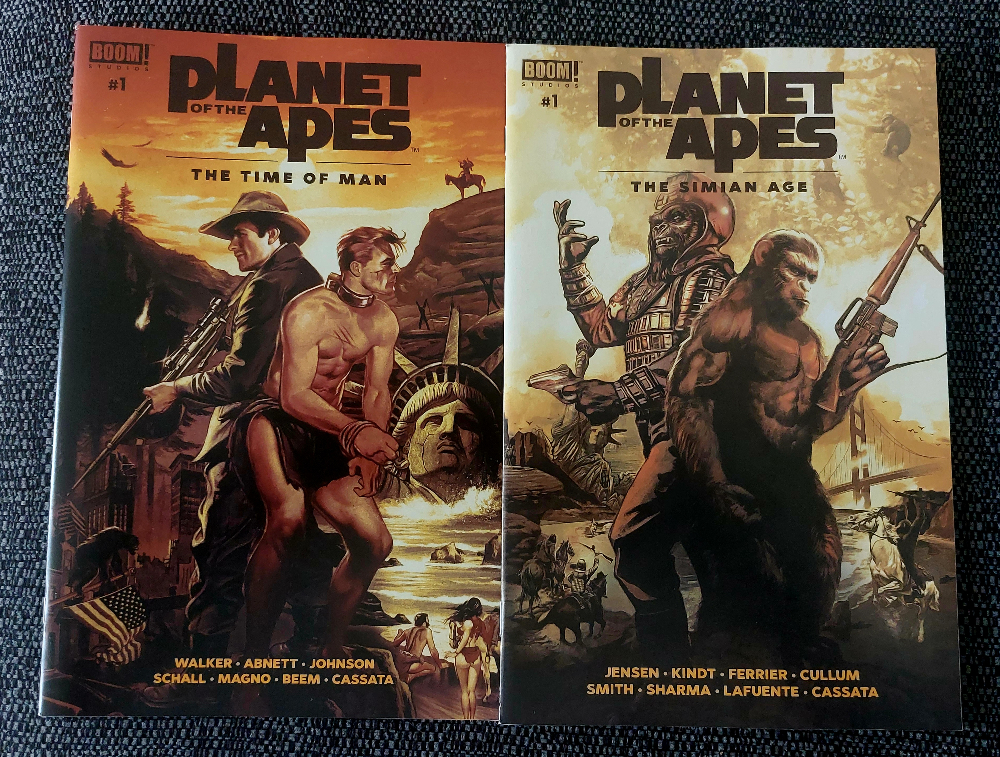
Credit: BOOM! Studios
Comic Number 173: The Time of Man and The Simian Age
These two are the newest comics in this week’s list. Both are BOOM! Studio annuals and are anthologies featuring several short stories set across a range of continuities. They are also the only comics I have read in the last two weeks that have any link with the rebooted Planet of the Apes movies, of which installment four is currently in the works. “Mountain” by Phillip Kennedy Johnson, Morgan Beem and Ed Dukeshire is a wonderful tale of humans hiding from the ape revolution. Fear is the enemy in this narrative and compassion is the hero. In contrast, “Cloud and Rain” by Ryan Ferrier, Lalit Kumar Sharma, Gabriel Cassara, and Ed Dukeshire demonstrates the power of hate and anger in manipulating the political and social worlds of ape and human.
The Time of Man features two more stories that both share an emotional outcome. One firmly set between the films Escape and Conquest, and the second set much later, detailing the treatment of human pets. This second story, written by Dan Abnett demonstrates the indifference that many of the ape’s have towards the humans, before the purge as depicted in other BOOM! Studios ape comics. But this is a reflection on the way that we, in our current society, treat our pets, wild animals, and to a certain degree the environment as a whole.
The Simian Age also contains three stories. One of them is about a rebellion born within a gorilla soldier who befriends some humans. However, it is the first story in the comic, Mother of Exiles, written by Jeff Jensen and illustrated by Jared Cullum that is the most interesting. The moving tale is helped along by the watercolor style artwork which creates a dreamy, wistful atmosphere. There is the sense of longing, of isolation, and then of hope. The ten page comic encapsulates the very best of Planet of the Apes, in references and emotional contexts. It stands above all of the other stories in these two comics despite each one being a worthy addition to Ape lore. The letters here are by Ed Dukeshire as well, who worked on all of these stories, which in itself is impressive. His work changes subtly between the era’s to reflect the slightly different tones and art styles. It’s fascinating to look at one creator’s work in conjunction with many others within one comic.
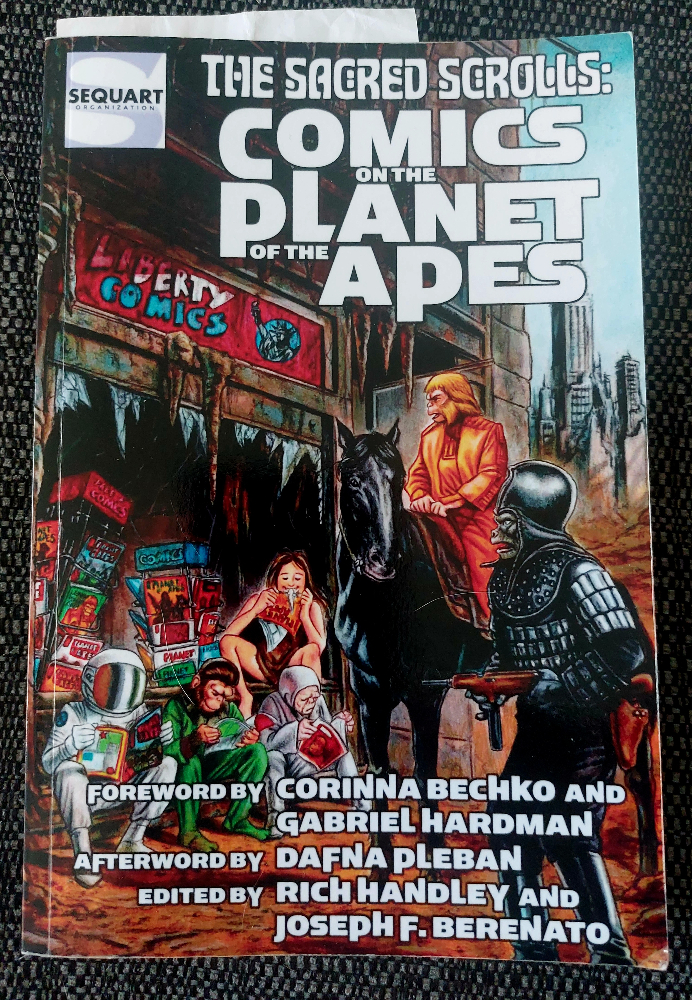
Credit: Sequart
Comic Number 174: The Sacred Scrolls: Comics on the Planet of the Apes (published by Sequart)*
Over the last two weeks, while reading Planet of the Apes comics, I have also been reading books and essays about the franchise that have increased my fascination with it. For example, Susan Bridget McHugh’s article in the South Atlantic Review (Vol 65 No 2) entitled Horses in Blackface: Visualizing Race as Species Difference in “Planet of the Apes” took the racial depiction within the movie franchise to new levels that I’d not even considered before. I am also re-reading John Jakes’ adaptation of Conquest on the Planet of the Apes and noticing turns of phrase and details that I hadn’t previously. And, I re-read The Sacred Scrolls, a wonderful book about the history of the comics from the franchise.
Broken down into a collection of essays focusing on different runs of the comic, The Sacred Scrolls takes an in-depth look at the narrative and artistic qualities of the comics and how they fit into the grander scheme of the franchise. I don’t think there is a single stone left unturned as the book covers comics from all over the world as well as touching on comics that were never even published. If you have any interest in the comics relating to Planet of the Apes, this book is indispensable. It is conversational in tone and doesn’t delve too deeply into sociological or political readings of the texts but then it is designed as a guide to what’s available and succeeds perfectly at being just that.
*I know, it’s not a comic but another book about comics. But I read 40+ issues last week, surely I’m ahead of the curve at this point?

